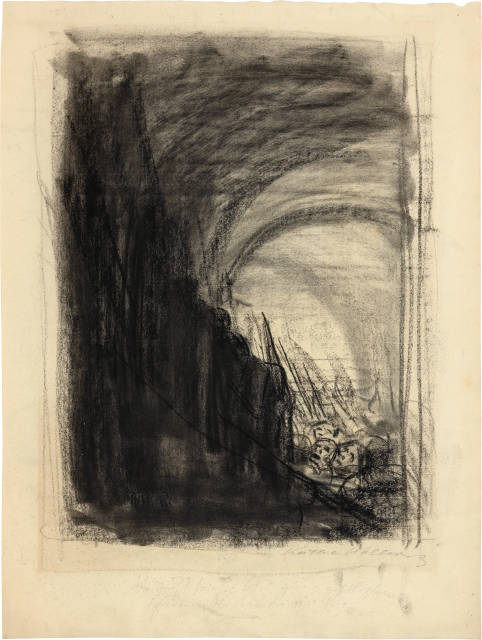- EN
Log in
- Live Auctions
- Past auctions
- More
- Gallery
- Art Dealing
- Publishing
- Kornfeld today
- The Story of Kornfeld
- Information




Königsberg 1867 - 1945 Moritzburg
1906
Charcoal on beige laid paper
58.9x44.4 cm
Signed "Käthe Kollwitz" in pencil by the artist lower right. Two lines of barely legible writing in the lower margin. On the reverse a study in charcoal of a standing girl and a child, repeated twice
Otto Nagel/Werner Timm, Käthe Kollwitz, Die Handzeichnungen, Œuvre-Katalog, Stuttgart 1980, no. 217
Collection Luise Diel, Berlin
Auction Gutekunst & Klipstein, Bern, 25 October 1951, lot 7, acquired there by
Private collection, Geneva, acquired there by
Private collection Switzerland
Minimally browned, slight lightstruck. Isolated small tears in paper margins and traces of old mounting on the reverse. In overall very good condition
As with her first graphic cycle "Ein Weberaufstand", Käthe Kollwitz also worked with a historical event in "Bauernkrieg". The starting point was probably the 1843 publication by the theologian and historian Wilhelm Zimmermann on the great German Peasants' War of 1524/1525, which social democratic circles soon referred to again and again, seeing in the oppressed peasants parallels to the proletariat. Kollwitz was also deeply affected by the book and planned a cycle in coloured lithographs (cf. the first version in lithograph "Bewaffnung in einem Gewölbe", Knesebeck 65, dated "vor Juni 1902"). When she was commissioned by the "Association for Historical Art" in 1904 through the mediation of Max Lehrs, the director of the Dresden Kupferstich-Kabinett, to create the works as an annual gift for the association, she executed the prints as etchings (cf. etching sheet 4 of the series "Bauernkrieg", Knesebeck 96, dated there "before mid-June 1906"). In 1907, she was the first woman to receive the "Villa Romana Prize", founded by Max Klinger, for the masterfully created and printed seven sheets (Knesebeck 70, 88, 96, 99-102) of the Peasants' War, even before the series was completed.
One of the particularly important preparatory drawings for the first version in lithograph and very similar to the well-known version in the National Gallery of Art in Washington, which impressively demonstrates the artist's creative process. With two charcoal drawings of two girls on the reverse.
1906
Kohle auf beigem Bütten
58,9x44,4 cm
Unten rechts von der Künstlerin in Bleistift signiert "Käthe Kollwitz". Im Unterrand zwei Zeilen einer kaum mehr leserlichen Schrift. Rückseitig eine zweimalig wiederholte Studie in Kohle zu einem stehenden Mädchen und einem Kind
Otto Nagel/Werner Timm, Käthe Kollwitz, Die Handzeichnungen, Œuvre-Katalog, Stuttgart 1980,
Slg. Luise Diel, Berlin
Auktion Gutekunst & Klipstein, Bern, 25. Oktober 1951, Los 7, dort erworben von
Privatsammlung, Genf, dort erworben von
Privatsammlung Schweiz
Minim gebräunt, leichter Lichtrand. Vereinzelte kleine Risschen im Papierrand und rückseitig Spuren alter Montierungen. In sehr schöner Gesamterhaltung
Wie bei ihrem ersten graphischen Zyklus "Ein Weberaufstand" arbeitete Käthe Kollwitz auch beim "Bauernkrieg" mit einem historischen Ereignis. Ausgangspunkt dürfte die 1843 erschienene Publikation des Theologen und Historikers Wilhelm Zimmermann über den grossen deutschen Bauernkrieg von 1524/1525 gewesen sein, auf die sich sozialdemokratische Kreise bald darauf immer wieder bezogen, da sie in den unterdrückten Bauern Parallelen zum Proletariat sahen. Auch Kollwitz war von dem Buch sehr betroffen und plante einen Zyklus in farbigen Lithographien (vgl. die erste Fassung in Lithographie "Bewaffnung in einem Gewölbe", Knesebeck 65, dort datiert "vor Juni 1902"). Als sie 1904 durch Vermittlung von Max Lehrs, dem Direktor des Dresdner Kupferstich-Kabinetts, von der "Verbindung für historische Kunst" beauftragt wurde, die Werke als Jahresgabe für die Vereinigung zu schaffen, führte sie die Graphiken als Radierungen aus (vgl. Radierung Blatt 4 der Folge "Bauernkrieg", Knesebeck 96, dort datiert "vor Mitte Juni 1906"). 1907 erhielt sie für die meisterhaft geschaffenen und gedruckten sieben Blätter (Knesebeck 70, 88, 96, 99-102) des Bauernkriegs als erste Frau noch vor der Fertigstellung der Serie den von Max Klinger begründeten "Villa-Romana-Preis".
Eine der besonders wichtigen Vorzeichnungen für die erste Fassung in Lithographie und sehr ähnlich der bekannten Version in der National Gallery of Art in Washington, die den Schaffensprozess der Künstlerin eindrücklich aufzeigt. Rückseitig mit zwei Kohlezeichnungen von zwei Mädchen.
| Switzerland | CHF | 145 |
| Europe | CHF | 255 |
| Overseas | CHF | 330 |





